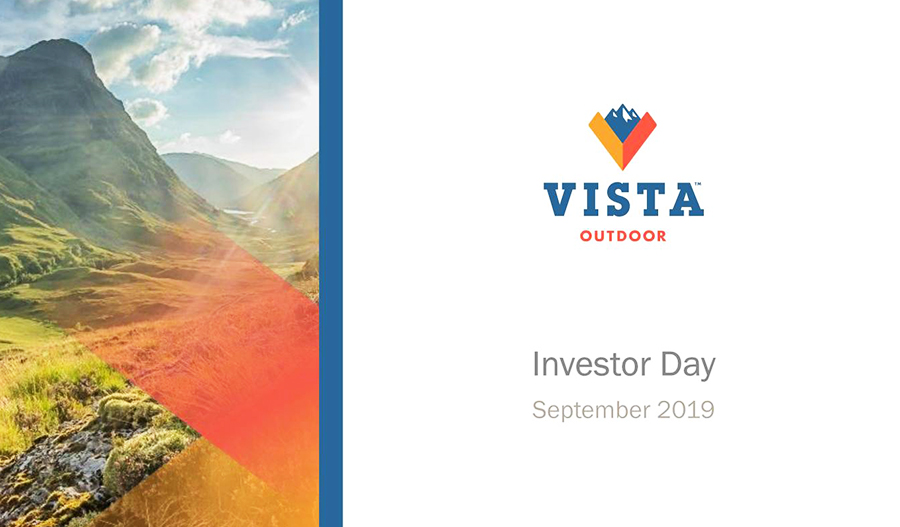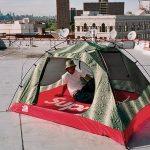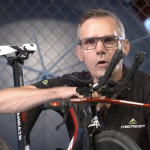<span style="color: #999999;">At Vista Outdoor’s Investor Day held Tuesday in New York City, company officials lowered revenue guidance for the current year due to Walmart’s decision to stop selling certain forms of ammunition. But a three-year plan was also revealed that calls for a return to modest growth in ensuing years along with significant improvement in profitability.
Under the plan, Vista’s goal calls for sales to expand at a rate between 2 to 3 percent over the next two-to-three years. That compares to sales that are expected to be flat-to-down 5 percent in the year ended March 30, 2020.
EBITDA margins are expected to expand to 10 percent of sales under the two-to-three-year goal, up from only 6 percent projected in fiscal 2020. Vista’s leverage ratio is also expected to be reduced dramatically, from 5 to 6 times in fiscal 2020 to 3 times under the two-to-three-year goal.
At the meeting, Vista’s CEO Chris Metz, who joined the company about two years after a career at Black & Decker and, most recently, at a private-equity firm focusing on turnarounds, detailed the recent struggles Vista has experienced. The challenges have led to massive write-downs, losses, steep sales declines, and a deteriorating stock price.
Metz said a foremost challenge has been a severe, politically-driven downturn in the ammunition market by 35 percent overall over the last two years driven by the election of President Trump. Vista’s ammunition unit managed to retain share over that time. He said, “I don’t know a business in my 30 years of experience that has had a tougher road in the last two years than our ammunition business.”
A second challenge has been the “retail apocalypse” marked by the bankruptcies and exits of Toys ‘R’ Us, Sports Authority and a number of wholesalers and distributors. Commodity prices, especially on materials like copper, have also been a major headwind. Finally, Metz noted some outsiders believe the company may have “paid too much for the assets that we bought” over the company’s buying binge by former management in past years to drive an over-leveraged condition.
Whether priced too high or not, Metz said the company has a stable of “great brands” that are the “absolute envy in the industry.” Many are leaders in their category and Metz said that’s why he took over as CEO and remains confident about Vista’s future.
He also believes the “Accelerated Transformation Plan” will lead to dividends in the coming years. A first step in the plan was reducing debt with the help of the sale of its eyewear business and Savage Arms. The company was able to rework its credit facility to have all its debt maturing in 2023.
The plan has further featured cost-cutting, streamlining efforts and SKU reductions to improve efficiencies and overhead, as well as strategic investments in digital, e-commerce and new leaders across functions and brands.
Vista is also seeking to better leverage its stable of market-leading brands by working together so that “one plus one equals three,” said Metz.
<span style="color: #999999;">Organizationly, the company is seeking to become “more nimble” to foster growth. Metz said that involves structural change and making brand managers more accountable, an issue across the Outdoor Products segment. Metz said, “You’ve seen us talk publicly about some of those changes and reconstituting the brands and creating a lean center of sport and a center of excellence to augment that. But this is also about structure. This is also about cultural change, and really changing the behaviors that we think lead to long-term success.”
Vista also at the meeting unveiled a new seven-point plan to drive underlying profitability and incorporate newer challenges, including Walmart’s recent decision and tariffs. Said Metz, “We feel like we are in front of it as much as we can be and have taken the proper steps to manage and control our own destiny.”
For the current year, sales are now expected to reach between $1.75 to $1.85 billion, down from previous guidance of $1.79 to $1.89 billion due to Walmart’s move. Metz expects any lost sales from Walmart will be absorbed by other channels in the long-term. Guidance for adjusted EPS in the year remained in the range of 10 to 25 cents.
Many of the specific strategies on the return to growth were outlined in presentations by specific brand managers.
…
Camp Chef has been a star among Vista Outdoor’s portfolio as sales have grown 15 percent on a CAGR (compound annual growth rate) basis since the business was acquired by Vista in 2016.
Brandon Sparrow, president of Camp Chef since September 2018, said that before Camp Chef arrived 30 years ago, there weren’t many options for outdoor cooking and outdoor enthusiasts generally had to “survive during meal times.” Researching professional kitchens, Camp Chef brought chef-style burners and other upgrades to bring modular cooking to the campsite and hike. Said Sparrow, “We developed our own market that wasn’t there before.”
Camp Chef is positioned in the premium area of the outdoor cooking space. Sparrow, who has been at Camp Chef for 20 years, believes it has acquired a strong reputation because the brand’s product “really works” versus the lower-price “gimmicky” or subpar options often found in the space.
Camp Chef’s reputation has helped the brand with its “influencer awareness strategy” as fans have increasingly spread the word on Camp Chef across social media in recent years. Influencer segments include camping and hiking, hunt & fish, “the moms of Camp Chef,” executive chefs, tailgating, dads and backyard grilling, celebrity chefs and competition barbecue. Instagram followers are up 85 percent year-over-year.
Digital engagement is also helping Camp Chef explore categories they weren’t able to develop at the store level. For example, Camp Chef now has a sizeable opportunity in tailgating after reaching football and other sports fans online.
A massive growth opportunity is seen in pellet grills, which Sparrow believes will “do for the grilling market what gas grills did to the charcoal market.” Flat-top grills are also an emerging category.
International remains largely untapped with Camp Chef entering Australia and Europe over the last 60 days. The brand will also seek to work with customers of Federal and Vista’s other outdoor brands on cross-selling opportunities. Said Sparrow, “Everybody has to cook.”
…
CamelBak detailed three strategies to return to growth: Optimize the Core (including enhancing retail execution and introducing relevant new products); Channel Expansion (led by digital and e-commerce investments); and Product Expansion (tapping the more than $1 billion addressable market in drinkware and daypacks.)
In hydration packs, Camelbacks has the dominant share, 70 percent, in bike, leads hike with a 25 percent share and is in the top-five in the run category with a 15 percent share. Daypacks were introduced this spring. In bottles, CamelBak leads the plastic category with a 30 percent share and dominates the bike category with a 70 percent share.
Greg Williamson, president at CamelBak, said a major focus will be placed on innovation. By 2021, 65 percent of CamelBak’s revenues are expected to come from products introduced this year through 2021.
Expansion opportunities include more vests and belts to support run hydration packs, a newer category for CamelBak. Big growth potential is also expected in stainless steel bottles. Williamson said the brand was a “little late in addressing” the steel category and has less than 1 percent share.
New caps and sizes, additional color palettes and sustainability stories are expected to support growth in the core water bottle business. More products designed exclusively for women, as well as featuring sustainable materials (recycled fishnets and plastic from bottles), are planned to help drive the core hydration packs business.
Like many of Vista’s other businesses, CamelBak has been taking costs out of the business and improving processes. Spending has been shifted toward digital marketing, consumer research and upgrading talent.
…
The Bike segment, Bell, Giro, Raskullz, Krash, and Blackburn, has faced sales challenges but also profitability challenges, in part due to tariffs that affected bike products starting in May. Vista recently ended plans to divest the Bike segment to focus on shoring up the segment’s profitability.
To enhance profitability, the Bike segment is working on reducing SKUs by 30 percent by the fourth quarter of fiscal 2020, revamping product development processes and using a “Sourced Plus” model for commodity goods. Tariff mitigation steps include re-pricing products, gaining concessions from factories, and finding alternative sources to China sourcing, including China factories looking to open factories in other countries.
Steps to return to the Bike segment to organic growth included launching new products, driving international growth, expanding into adjacent categories, continuing investments in Direct-to-Consumer/e-commerce and expansion in the Bell Powersports business.
Ric Kern, VP and general manager of Bell (mass), which is part of the Action Sports division, said the segment’s products range from $15 kids helmets to $400 helmets worn by participants in the Tour de France. He said, “We truly dominant in head protection.”
Giro and Bell are the primary brands in the segment. Giro has the leading share in cycling and snowsports helmets in the U.S. specialty channel, the number two share in snow goggles and number four in cycling footwear. Continuing innovation, new products, expanding the brand’ social presence, and grassroots outreach are expected to drive Giro’s growth.
Bell has the number three position in U.S. bicycle helmets in the special channel and the leading position in U.S Powersports helmets. Growth initiatives include new product innovation such as Flex and ProTint technologies, digital transformation and Powersports expansion in Europe.
At the mass level, Bell has 50 percent of the market share in bike helmets and accessories. Mass includes retailers such as Amazon, Walmart, Target and Dick’s. Bell’s mass business has been helped by technology take-downs form the specialty side and mass offerings now include MIPS technology, USB rechargeable bike lights and LED-infused helmets. Securing licenses with Disney, Marvel, Nickelodeon, Hello Kitty and others have strongly supported kids. Said Kern, “Kids don’t want to wear a helmet but will wear Spiderman on their head.”
…
Vista’s Hunt/Shoot segment also expects innovation to revive growth. Vishak Sankaran, president of the segment, said, “We know the hunting market is soft. So how do you grow? By understanding the consumer and translating their insights to come up with innovative product.”
Vista’s Hunt/Shoot business features brands including Bushnell, Bushnell Golf., Primos, Hoppe’s, and Blackhawk. The brands reach an addressable market of $3 billion. Many are over 70 years old and have leading positions in their category, whether hunting accessories, shooting accessories, tactical, observation (binoculars) and golf EMDs (electronic measuring devices).
The return to growth for the segment includes leveraging its increasingly nimble platform, delivering innovative products, growing market share internationally, expanding into adjacent categories and capitalizing on digital and e-commerce capabilities.
The Hunt/Shoot segment has undergone a significant reorganization with the hunt downturn to drive efficiencies with many of those moves supported by Vista’s corporate scale and integrated systems. Distribution centers have been consolidated to six from 13, manufacturing facilities reduced to six from eight, and SKUs from 13,500 to 8,000. The group has a targeted sourcing cost reduction goal of 2 to 3 percent annually.
Sankaran steadily called out innovation as the path to resuming growth by making products simpler to use, better performing and more appealing through ergonomic design. Recent successes include the Bushnell Golf’s ProXE Rangefinder, Butler Creek’s ASAP Magazine Loader and Primo’s SurroundView Technology Blind. SurroundView Technology that provides a 360-view for the hunter helped drive Primos’ blind sales up 60 percent so far in the current year.
Other growth opportunities include expansion in the Europe and APAC region. Bushnell golf already has a double-digit share in Europe.
Online, the Hunt/Shoot segment has been boosted by brand-specific pages and bundling opportunities that are helping drive up average selling prices. Year-to-date, web traffic across Hunt/Shoot websites increased 1 percent and DTC sales have grown 270 percent. Adjacent categories are also an opportunity, particularly for the Bushnell brand in camping and lighting.
…
The Ammunition segment of Vista Outdoor (Federal, Speer and CCI) has been most impacted by the slowdown in the domestic commercial segment since the election of President Trump, but it counts healthy growth channels in domestic law enforcement, international commercial and military/international law enforcement, said Jason Vanderbrink, president of the segment.
The segment has by far the dominant position in the U.S. law enforcement market with nearly 70 percent share and provides all the ammunition to major cities such as New York, Los Angeles and Detroit.
In the domestic commercial segment, growth has been steadily growing at a 5.3 percent CAGR since 1992 through 2018 even with the erosion in the last three years. Vista’s business continues to be the leader in domestic commercial ammunition and growth opportunities are seen in a highly-fragmented market outside the top three players.
Among categories, Vista’s ammunition segment leads and is growing share in pistols and rimfires. With the Federal brand, the segment is leading share and holding its position in rifles. In the shotshell market, Vista is in the top three position and holding share.
One path to growth for the ammunition segment is partnerships with gun manufacturers that had been reluctant to partner given Vista’s ownership of Savage Arms. Partnerships have been formed with Ruger and Henry Firearms. New product introductions are particularly expected to drive growth, with recent successes including the Premium Bismuth, Segmented Buckshot and 224 Valkyrie.
Online, Vista became the first major ammunition company to sell DTC with the launch of an e-commerce platform for Speer on November 2018. A site for Federal went live on July 2019. Vanderbrink said Vista is able to showcase a much broader selection online and better alert dealers to strong sellers. With Federal Custom Shop set to launch this fall, Vista will debut the ammunition industry’s first custom design shop.
Vista’s ammunition business has also benefited from the launch of the Premium 365 Program tailored to independent dealers. Vanderbrink said the company had become “too reliant” on big boxes. The ammunition business is also expected to benefit from ongoing efforts to reduce costs and leverage Vista’s scale.
Sales are expected to decline to $1.8 billion this year and reach a range of $1.6 to $1.8 billion in fiscal 2022. Vista expects to potentially lose $300 million revenues from divestitures as the company said it may sell the Bike segment once profitability improves. Vista has modest expectations from other initiatives, including $100 million from new products and online revenues. Another $100 million is expected from tuck-in acquisitions that will be explored once Vista achieves its leverage goals.
Photo courtesy Vista Outdoor
















